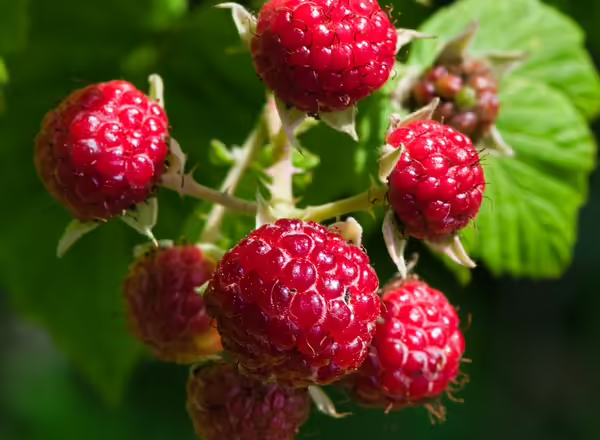Fertilizing
Fertilize raspberry plantings about 10 to 14 days after planting. Apply about two ounces of a 5-10-5 fertilizer around each plant. Starting the second season and annually thereafter, fertilize raspberries in early spring before growth begins. Apply a balanced fertilizer, such as a 10-10-10, at a rate of 15 to 20 pounds of fertilizer per 1,000 square feet of planting. If using the hill system, apply about one-half cup per plant. Don't fertilize raspberries in late summer or early fall as it may force new growth that does not harden off properly for winter.
Raspberries grow best when some type of support is provided for the canes. Plants may be planted in hills or hedgerows. Red raspberries will readily spread by root suckers while purple and black do not. If using the hill system, plants are grouped around a strong stake or pole, and then trained to grow on the support.
Trellises
Raspberries can also be grown on trellises in rows. One method is to run 2 wires about 18 inches apart horizontally between posts with cross bars. This set of wires should be about three feet off the ground. The raspberries then grow up between the wires and are supported. This creates a hedge of raspberries about 18 inches wide or so. This method is popular and does not require any tying of the canes to the supports.
Another option is to run two wires about two feet apart vertically between posts, and the raspberry canes are tied to the wire supports. The lower wire should be about three feet off the ground.
Pruning
Raspberries must be pruned on a regular basis to stay productive. The basic rule to remember in summer bearing raspberries is that fruit is produced on the cane in the second year of the cane's growth, then that cane dies and should be removed. Pruning needs vary with the type of raspberry being grown, however. Red and yellow raspberries should be pruned twice a year. Early spring pruning should remove weak canes and then a second pruning should be done right after harvest to remove canes that have fruited. Do not summer prune, or what's often called topping, red or yellow raspberries. Another option with everbearing cultivars, such as 'Heritage,' is to grow them for a fall crop only. These types will fruit the first fall of the canes' growth, then further down on the cane the following season. All canes can be removed in late fall so only the fall crop is used. Often yields and berry quality is superior when following this method for these types of raspberries.
Purple and black raspberries require pruning three times a year. In addition to the spring and after harvest pruning mentioned above, they also require summer topping to encourage development of lateral shoots off the canes. All new shoots should be pinched back in summer 3 to 4 inches once they have reached desired height. Lateral branches then develop that will produce fruit.
Regular pruning helps reduce cane blight and other disease concerns. Viruses are also a potential major disease problem. Plants infected with virus will appear stunted, dwarfed, and will be unproductive. It is suggested that you go through the raspberry plantings at least twice a year to scout for virus infected plants. Remove and destroy these plants as soon as they are noticed. Always purchase certified nursery stock to help reduce potential virus problems. Do not share plants with other gardeners that have been dug out of gardens and keep wild brambles in the area under control.

- Plant on elevated sites with well drained soils.
- Prepare the soil at least one year before planting.
- Eliminate all perennial weeds.
- Add 10-20 tons of manure per acre.
- Do a pre-plant soil test, and add nutrients if needed.
- Adjust soil pH to 5.8-6.5.
- Apply nitrogen (1.5 ounces/plant) when raspberries are 6 to 8 weeks old. Repeat later after the same period of time. This is done when soil organic matter is low during the first year.
- Dip cuttings or seedling roots into Galltrol-A solution when planting in soil that is infested with crown gall-causing organisms.
- Spread 4-6 inches of well-rotted saw dust or clean straw as mulch.

- Apply 2 to 4 ounces of ammonium nitrate per original plant every spring or alternatively use equivalent lower rates of 10-10-10 compound fertilizers.
- Ensure higher fertilizer rates in sandy soils and with older plants.
- In early August, large growers should take samples of newly expanded leaves for analysis of plant nutrients.
- Keep the area between rows weed free. This can also be achieved by seeding perennial grass or a mixture of grass and a legume as a cover crop.
- When controlling weeds around the plants, do not dig 2 to 3 inches deep to avoid root injury.
- Use trellis support to protect plants from wind injury.